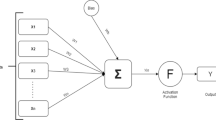Abstract
There are three disadvantages of weighted scoring stock selection models. First, they cannot identify the relations between weights of stock-picking concepts and performances of portfolios. Second, they cannot systematically discover the optimal combination for weights of concepts to optimize the performances. Third, they are unable to meet various investors’ preferences. This study aimed to more efficiently construct weighted scoring stock selection models to overcome these disadvantages. Since the weights of stock-picking concepts in a weighted scoring stock selection model can be regarded as components in a mixture, we used the simplex-centroid mixture design to obtain the experimental sets of weights. These sets of weights are simulated with US stock market historical data to obtain their performances. Performance prediction models were built with the simulated performance data set and artificial neural networks. Furthermore, the optimization models to reflect investors’ preferences were built up, and the performance prediction models were employed as the kernel of the optimization models, so that the optimal solutions can now be solved with optimization techniques. The empirical values of the performances of the optimal weighting combinations generated by the optimization models showed that they can meet various investors’ preferences and outperform those of S&P’s 500 not only during the training period but also during the testing period.












Similar content being viewed by others
References
Asness CS, Moskowitz TJ, Pedersen LH (2013) Value and momentum everywhere. J Financ 68(3):929–985
Atsalakis GS, Valavanis KP (2009) Surveying stock market forecasting techniques—part II: soft computing methods. Expert Syst Appl 36(3):5932–5941
Bahrammirzaee A (2010) A comparative survey of artificial intelligence applications in finance: artificial neural networks, expert system and hybrid intelligent systems. J Neural Comput Appl 19(8):1165–1195
Banz RW (1981) The relationship between return and market value of common stocks. J Financ Econ 9:3–18
Cao Q, Leggio KB, Schniederjans MJ (2005) A comparison between Fama and French’s model and artificial neural networks in predicting the Chinese stock market. Comput Oper Res 32:2499–2512
Cheh JJ, Weinberg RS, Yook KC (2013) An application of an artificial neural network investment system to predict takeover targets. J Appl Bus Res 15(4):33–46
Choudhury S, Ghosh S, Bhattacharya A, Fernandes KJ, Tiwari MK (2014) A real time clustering and SVM based price-volatility prediction for optimal trading strategy. Neurocomputing 131:419–426
Eakins SG, Stansell SR (2003) Can value-based stock selection criteria yield superior risk-adjusted returns: an application of neural networks. Int Rev Financ Anal 12:83–97
Fama EF (1970) Efficient capital markets: a review of theory and empirical work. J Financ 25(2):383–417
Fama E, French K (1998) Value versus growth: the international evidence. J Financ 53(6):1975–2000
Hart J, Slagter E, Dijk D (2003) Stock selection strategies in emerging markets. J Empir Finance 10:105–132
Haykin S (2007) Neural networks: a comprehensive foundation. Prentice Hall, Englewood Cliffs
Holthausen R, Larker D (1992) The prediction of stock returns using financial statement information. J Account Econ 15:373–411
Hong H, Lim T, Stein JC (2000) Bad news travels slowly: size, analyst coverage, and the profitability of momentum strategies. J Financ 55(1):265–295
Jane CJ, Chang TC (2013) A fusion model for stock selection based on decision tree, artificial neural network and grey relational analysis. Int J Kansei Inf 4(3):115–122
Jegadeesh N, Titman S (1993) Returns to buying winners and selling losers: implications for stock market efficiency. J Financ 48(1):65–91
Mohanram S (2005) Separating winners from losers among low book-to-market stocks using financial statement analysis. Rev Account Stud 10(2–3):133–170
Montgomery DC (2008) Design and analysis of experiments. John Wiley & Sons Inc, New York
Myers RH, Montgomery DC (2009) Response surface methodology. John Wiley & Sons Inc, New York
Nanda S, Ahmed P (2001) Style investing: incorporating growth characteristics in value stocks. J Portf Manag 27(1):47–59
Nanda SR, Mahanty B, Tiwari MK (2010) Clustering Indian stock market data for portfolio management. Expert Syst Appl 37(12):8793–8798
Noma M (2010) Value investing and financial statement analysis. Hitotsubashi J Commer Manag 44(1):29–46
Olson D, Mossman C (2003) Neural network forecasts of Canadian stock returns using accounting ratios. Int J Forecast 19:453–465
Piotroski J (2000) Value investing: the use of historical financial statement information to separate winners from losers. J Account Res 38:1–41
Quah Tong-Seng (2008) DJIA stock selection assisted by neural network. Expert Syst Appl 35:50–58
Roko I, Gilli M (2008) Using economic and financial information for stock selection. CMS 5(4):317–335
Rosenberg B, Reid K, Lanstein R (1985) Persuasive evidence of market inefficiency. J Portf Manag 11(3):9–17
Ren N, Zargham M, Rahimi S (2006) A decision tree-based classification approach to rule extraction for security analysis. Int J Inf Technol Decis Mak 5(1):227–240
Sadigh AN, Mokhtari H, Iranpoor M, Ghomi SMT (2012) Cardinality constrained portfolio optimization using a hybrid approach based on particle swarm optimization and Hopfield neural network. Adv Sci Lett 17(1):11–20
Sorensen E, Miller K, Ooi C (2000) The decision tree approach to stock selection. J Portf Manag 27(1):42–53
Yeh IC, Cheng WL (2010) First and second order sensitivity analysis of MLP. Neurocomputing 73(10):2225–2233
Yeh IC, Hsu TK (2011) Growth value two-factor model. J Asset Manag 11(6):435–451
Author information
Authors and Affiliations
Corresponding author
Rights and permissions
About this article
Cite this article
Liu, YC., Yeh, IC. Using mixture design and neural networks to build stock selection decision support systems. Neural Comput & Applic 28, 521–535 (2017). https://doi.org/10.1007/s00521-015-2090-x
Received:
Accepted:
Published:
Issue Date:
DOI: https://doi.org/10.1007/s00521-015-2090-x




